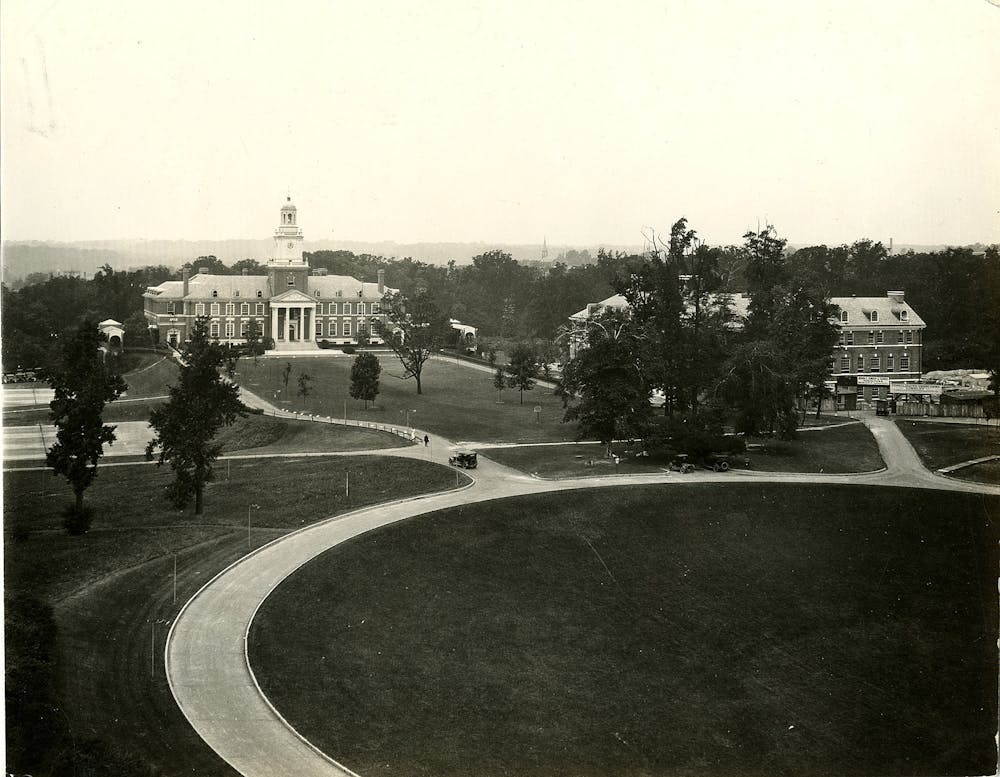Arguably known as the central landmark of the Homewood campus, Gilman Hall is often regarded as the first major academic building on Homewood campus. Construction commenced on Gilman Hall in 1913, and the $509,063 project — equivalent to $10 –11 million dollars in 2023 — was completed in 1915. Offices moved in the summer of that year.
Designed by Douglas Thomas, Gilman Hall is named in memory of the first president of the University, Daniel Coit Gilman, who became president in 1876. Gilman shaped the University based on the model of German research institutions and helped define Hopkins as one of the first and most robust research universities. Gilman Hall originally housed a library, seminar rooms and department offices.
Prior to Milton S. Eisenhower Library’s construction in 1964, Gilman Hall also served as the main library on campus. After 1964, books were moved out of Gilman, and faculty used the 25,000 square feet of previous library space for storage.
In 2010, the University completed a three-year renovation of Gilman Hall. Totaling $85 million, the renovation included the addition of a new archeology museum and the construction of the Gilman Atrium. The major renovation removed the outdoor courtyard hallway that connected the Memorial Hall to the Hutzler Reading Room, replacing it with an atrium with seating for students and a 60-by-60 foot glass skylight. The Gilman Atrium was designed by Frances Halsband and displays various sculptural pieces, including Vessel Field by artist Kendall Buster.
Richard Kagan, professor emeritus of History, worked at Hopkins from 1972 to 2013. Kagen’s office resided in Gilman for almost all of that time, and he served on the committee overseeing the renovation in 2010.
Kagan described how the atrium looked prior to the renovation in an interview with The News-Letter.
“Gilman Hall was created with the old library in the middle and the offices around,“ he said. “By the time I got [to Hopkins] in 1972, that part of Gilman was used only for storage because all the books were already in the Eisenhower library, and some of those interior spaces had been converted into offices, looking onto a dingy little bit of courtyard.”
The courtyard, now the Gilman Atrium, was inaccessible to faculty and students and had little funtion.
Kagan discussed the renovation committee’s inspiration for removing the hallway connecting Memorial Hall and the reading room.
“We said, ‘Let’s get rid of that corridor,’” he said. “One of the inspirations came from the Beinecke Rare Book Library at Yale. What we need is an open space covered so people can gather, and students and faculty can gather.”
Following the renovation, all 10 humanities departments at Hopkins were once again in the same building, following a period where some were forced to move to other buildings due to lack of space.
During the rededication of Gilman Hall in 2010, President Ronald J. Daniels expressed the important role of the humanities at Hopkins.
“The lofty clock tower and the chimes that ring out on the quarter hour from Gilman Hall are constant and evocative reminders of the signature place the humanities hold in our University and in our world,“ he said. “In reconsecrating Gilman Hall, we powerfully reaffirm our commitment to the future of the humanities at [the University].”
Another significant aspect of the renovation was the construction of a new archeology museum, located directly below the atrium, displaying the University’s collection of ancient artifacts and artifacts on loan from Eton College as part of a 15-year program.
Professor Emeritus Betsy Bryan of the Near Eastern Studies Department has been at Hopkins since 1986 and has worked in Gilman for the entirety of that time. In an interview with The News-Letter, Bryan noted the positive effects of the renovation on the museum.
“There was always a museum, the problem was that it was in a section, which is now the museum storage room, and it had no outside light,“ she said. “It was really horrendously awful.”
Bryan explained that the renovation has improved awareness and student utilization of the archeology museum, giving students new opportunities to work with pieces.
“It’s been an enormous sea of change in terms of how many people know we have a museum, how many people use it, how many students come through there take classes that are related to it,“ she said. “[Without the renovation] I know that we would never have been able to attract the number of students who come in there and get a chance to actually work with pieces on their own.”
Although the renovation took steps to improve Gilman Hall, it also managed to keep intact unique historical features, including the signature seal in the main foyer.
Sophomore Spriha Thapa, a tour guide with Blue Key Society, spoke on her experiences giving tours in Gilman in an interview with The News-Letter.
“[Prospective students] think Gilman is cool because we tell them the seal joke,” she said. “If you are a prospective student and you step on the seal, then you won't get in. If you're a current student and you step on the seal, then you won't graduate. If you're [an untenured] professor and you step on the seal, you won't get tenured.”
Kagan explained how the architects preserved Gilman’s historical features.
“One of the... worries the faculty had [was that] we love the high ceilings in Gilman, and we were amazed that... rather than modernize the building and make it look like Ames or other buildings with low drop ceilings and the like, they maintain[ed] the high ceilings,“ he said.





